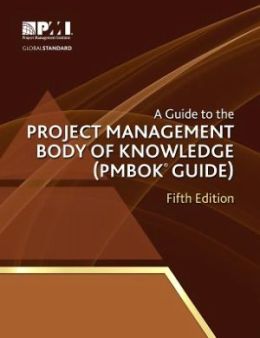 Many people have trouble understanding the difference between Quality Assurance (QA) and Quality Control (QC) as they are preparing for their Project Management Professional (PMP)® Exam.
Many people have trouble understanding the difference between Quality Assurance (QA) and Quality Control (QC) as they are preparing for their Project Management Professional (PMP)® Exam.
That is not surprising. The terms are very closely related and if you don’t work in the field, the difference doesn’t seem too obvious.
And when you look into A Guide to the Project Management Body of Knowledge (PMBOK® Guide) glossary, you'll find that neither Quality Assurance nor Quality Control is defined. Instead, you will only find a definition for the respective processes of Perform Quality Assurance and Control Quality. The PMBOK® Guide is as always a bit dry in its definitions.
Continue Reading
Knowing concepts that are no longer in The Guide
 Most exams cover material you’ve studied but sometimes the Project Management Professional (PMP)® exam includes questions that were not in the version of A Guide to the Project Management Body of Knowledge (PMBOK® Guide) that you have studied. This can really throw you for a loop but if you’re prepared for it, it won’t be such a shock. The thing to remember is that the PMBOK® Guide is just that - a guide, not an exact accounting of every tool and concept that you will be using as a project manager and PMP®. For instance, techniques such as AON and AOA are still used by project managers around the world even though they were removed from the PMBOK® Guide.
Most exams cover material you’ve studied but sometimes the Project Management Professional (PMP)® exam includes questions that were not in the version of A Guide to the Project Management Body of Knowledge (PMBOK® Guide) that you have studied. This can really throw you for a loop but if you’re prepared for it, it won’t be such a shock. The thing to remember is that the PMBOK® Guide is just that - a guide, not an exact accounting of every tool and concept that you will be using as a project manager and PMP®. For instance, techniques such as AON and AOA are still used by project managers around the world even though they were removed from the PMBOK® Guide.
Continue Reading
How To Calculate Network Diagram for PMP® Exam
 We recently received the following question from a Project Management Professional (PMP)® Exam Student:
We recently received the following question from a Project Management Professional (PMP)® Exam Student:
“There's some confusion in my head with regards to some of the network diagram calculations. I'm lead to believe there are actually two methods to calculate ES, LF, ES etc etc
The first method adds or subtracts 1 where applicable. This assumes that the start activity has ES, EF, LS and LF as 1. The second method assumes the start activity has zeros for all values thereby not having to add or subtract 1 to any of the formulas.
Is there any indication in the exam that would lead me into knowing which "method" is being utilised so that I can apply the right formula?”
I answered that he is correct. there are indeed 2 approaches:
- First approach: You calculate the network diagram starting on day 0
- Second approach: You calculate the network diagram starting on day 1
I personally use the second approach to calculate for the network diagram, because when my sponsor tells me, that my project starts on the first day of September, then that is September 1 and not September 0. This is also the way that all modern scheduling tools seem to work. You schedule your project based on a calendar start date and not "on day 0".
That is why there is a slight difference between the calculations (you have to add/subtract 1 from the results in the 2nd approach). However, don't worry about this for the PMP® exam too much. The way that the question is formulated you should be able to identify how to go about this. Also: I understand that in most cases when you have to calculate this, it is the end result that is important and not how you got there.
If you want to study the correct formulas for your PMP Exam, then this guide is a must-have. Watch this video:
Communications Channels Formula for Communications Management
 The communications channels formula is N * (N-1) / 2. It is a way to numerically show the importance of proper communications management on a project. We all have a "gut feeling" in regards to this and most people would agree that "the larger the project, the more communications becomes a challenge".
The communications channels formula is N * (N-1) / 2. It is a way to numerically show the importance of proper communications management on a project. We all have a "gut feeling" in regards to this and most people would agree that "the larger the project, the more communications becomes a challenge".
The communications channel formula is a way to express this "challenge" numerically.
First of all, it expresses that the number of people on the project is at the heart of what makes communications a challenge. It's not the size of the budget or the the technical complexity that poses our greatest communications challenge. It is the number of people with whom we need to communicate about our budget and technology that makes it harder, the more people we involve.
Second, the formula acknowledges, that it is not only us (the project manager) who has to communicate. The formula takes into account that on a 5 people team it is not just me who is communicating with 4 others, but it's everyone talking to everyone. The number of people who are constantly communicating with each other is much larger than that.
This second point highlights 2 facts: 1.) Harold Kerzner's figure that a project manager spends 90% of her/his time communicating suddenly makes a lot more sense. 2.) It is impossible for us to try and manage all the various conversations that will be going on between the members of our project team.
Third and last, I use the communications channels formula as a "teaching tool". Both in a classroom and an office environment. In the classroom this is simply the formula that you have to know for your Project Management Professional (PMP)® Exam. There is a very high likelyhood that one of the 200 questions on your exam will include this question. Second being able to discuss this formula with the project sponsor and project team on an actual project allows me to highlight why we cannot just simply "do" communications. We have to plan the how, what, when, why and with whom we communicate early on in the project, so that communications will be effective and efficient.
Interpersonal Skills a PMP® Needs: 8. Negotiation Skills
 In Appendix G, A Guide to the Project Management Body of Knowledge (PMBOK® Guide) discusses Interpersonal Skills for the project manager. We are currently reviewing these one by one in our weekly Project Management Professional (PMP)® exam tip and we have reached the last one in the series: Negotiation.
In Appendix G, A Guide to the Project Management Body of Knowledge (PMBOK® Guide) discusses Interpersonal Skills for the project manager. We are currently reviewing these one by one in our weekly Project Management Professional (PMP)® exam tip and we have reached the last one in the series: Negotiation.
The nature of the role of a project manager makes it essential for them to have good negotiation skills. There are usually many stakeholders involved in the project and most projects have team members from different departments. This usually results in several different points of view which can sometimes make it difficult to keep the project on track and within the original scope.
Negotiation skills help a project manager by reaching an agreement or a compromise of some kind on the issue that may be causing a problem or delay.
There are many negotiation skills that you should be able to use related to negotiation. These include being able to analyze each situation, being an active listener and clearly communicating throughout the discussion. It can be useful to identify the differences between the wants vs the needs of those involved. Another important focus is to realize the difference between the positions people have vs the interests and issues directly related to the project.
Above all, skilled negotiators have the ability to manage the situation so that all parties involved feel as though they had a say that was taken into consideration.
 The Precedence Diagramming Method (PDM) is a tool for scheduling and sequencing events in a project plan based on their relationships with other events. The model allows you to visually map activities and their dependencies. Within this model there are four types of dependencies or logical relationships that are possible: finish-to-start (FS), finish-to-finish (FF), start-to-start (SS), and start-to-finish (SF). The start-to-finish relationship seems to be the model that causes the most confusion for students of the Project Management Professional (PMP)® exam, perhaps because there are not many good examples of this relationship. Start-to-finish occurs when “the completion of the successor activity depends on the initiation of the predecessor activity,” or, said so that normal folks can process it: Activity A must start before Activity B can finish.
The Precedence Diagramming Method (PDM) is a tool for scheduling and sequencing events in a project plan based on their relationships with other events. The model allows you to visually map activities and their dependencies. Within this model there are four types of dependencies or logical relationships that are possible: finish-to-start (FS), finish-to-finish (FF), start-to-start (SS), and start-to-finish (SF). The start-to-finish relationship seems to be the model that causes the most confusion for students of the Project Management Professional (PMP)® exam, perhaps because there are not many good examples of this relationship. Start-to-finish occurs when “the completion of the successor activity depends on the initiation of the predecessor activity,” or, said so that normal folks can process it: Activity A must start before Activity B can finish. “Decomposition” and “work breakdown” are probably not the first words you want to hear with respect to the project you’re managing. However, Decomposition is perhaps the most important technique to understand when it comes to the Scope Management section of the PMI's Project Management Professional (PMP)® exam. Decomposition involves breaking down the overall project workload into smaller, more manageable tasks. These tasks can subsequently be broken down into smaller tasks until each piece of work can be prioritized, assigned to resources, and tracked in the form of a Work Breakdown Structure (WBS). The idea is to move from large, general deliverables to the specific work packages and tasks that make up each deliverable. In essence, you’re carving up the individual puzzle pieces that make up the puzzle as a whole.
“Decomposition” and “work breakdown” are probably not the first words you want to hear with respect to the project you’re managing. However, Decomposition is perhaps the most important technique to understand when it comes to the Scope Management section of the PMI's Project Management Professional (PMP)® exam. Decomposition involves breaking down the overall project workload into smaller, more manageable tasks. These tasks can subsequently be broken down into smaller tasks until each piece of work can be prioritized, assigned to resources, and tracked in the form of a Work Breakdown Structure (WBS). The idea is to move from large, general deliverables to the specific work packages and tasks that make up each deliverable. In essence, you’re carving up the individual puzzle pieces that make up the puzzle as a whole. Many people have trouble understanding the difference between Quality Assurance (QA) and Quality Control (QC) as they are preparing for their Project Management Professional (PMP)® Exam.
Many people have trouble understanding the difference between Quality Assurance (QA) and Quality Control (QC) as they are preparing for their Project Management Professional (PMP)® Exam. Most exams cover material you’ve studied but sometimes the Project Management Professional (PMP)® exam includes questions that were not in the version of
Most exams cover material you’ve studied but sometimes the Project Management Professional (PMP)® exam includes questions that were not in the version of  We recently received the following question from a Project Management Professional (PMP)® Exam Student:
We recently received the following question from a Project Management Professional (PMP)® Exam Student: The communications channels formula is N * (N-1) / 2. It is a way to numerically show the importance of proper communications management on a project. We all have a "gut feeling" in regards to this and most people would agree that "the larger the project, the more communications becomes a challenge".
The communications channels formula is N * (N-1) / 2. It is a way to numerically show the importance of proper communications management on a project. We all have a "gut feeling" in regards to this and most people would agree that "the larger the project, the more communications becomes a challenge". In Appendix G,
In Appendix G,